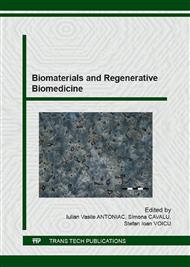[1]
J.S. Boateng, K.H. Matthews, H.N.E. Stevens, G.M. Eccleston, Wound healing dressings and drug delivery systems: a review. J. Pharm. Sci. 97 (2008) 2892-2923.
DOI: 10.1002/jps.21210
Google Scholar
[2]
B. Albertini, M. Di Sabatino, N. Calonghi, L. Rodriguez, N. Passerini, Novel multifunctional platforms for potential treatment of cutaneous wounds: development and in vitro characterization. Int. J. Pharm. 440(2) (2013) 238-249.
DOI: 10.1016/j.ijpharm.2012.06.004
Google Scholar
[3]
P.S. Murphy, G.R.D. Evans, Advances in wound healing: a review of current wound healing products, Plast. Surg. Int. (2012) 190436-190438.
Google Scholar
[4]
V. Trandafir, G. Popescu, M.G. Albu, G. Popescu , H. Iovu, Bioproducts based on collagen, Ars Docendi Publishing House, Bucharest, (2007).
Google Scholar
[5]
M.G. Albu, M. Ferdes, D.A. Kaya, M.V. Ghica, I. Titorencu, L. Popa, L. Albu, Collagen wound dressings with anti-inflammatory activity, Mol. Cryst. Liq. Cryst. 555: 1(2012) 271-279.
DOI: 10.1080/15421406.2012.635556
Google Scholar
[6]
A.K. Kirichenko, I.N. Bolshakov, A.E. Ali-Riza, A.A. Vlasov, Morphological study of burn wound healing with the use of collagen-chitosan wound dressing, Bull. Experim. Biol. Med. 154(5) (2013) 692-696.
DOI: 10.1007/s10517-013-2031-6
Google Scholar
[7]
I. Antoniac, Biodegradability of some collagen sponges reinforced with different bioceramics, KEM, 587 (2014) 179-184.
DOI: 10.4028/www.scientific.net/kem.587.179
Google Scholar
[8]
T. Petreus, B.A. Stoica, O. Petreus, A. Goriuc, C.E. Cotrutz, I.V. Antoniac, L. Barbu-Tudoran, Preparation and cytocompatibility evaluation for hydrosoluble phosphorous acid-derivatized cellulose as tissue engineering scaffold material, JMS-MM, 25(4), (2014).
DOI: 10.1007/s10856-014-5146-z
Google Scholar
[9]
I.C. Stancu, D.M. Dragusin, E. Vasile, R. Trusca, I. Antoniac, D.S. Vasilescu, Porous calcium alginate-gelatin interpenetrated matrix and its biomineralization potential, JMS-MM, 22(3), (2011) 451-460.
DOI: 10.1007/s10856-011-4233-7
Google Scholar
[10]
I. Titorencu, M.G. Albu, M. Giurginca, V. Jinga, I. Antoniac, V. Trandafir, C. Cotrut, F. Miculescu, M. Simionescu, In vitro biocompatibility of human endothelial cells with collagen-doxycycline matrices, Molecular Crystals and Liquid Crystals, 523 (2010).
DOI: 10.1080/15421401003724126
Google Scholar
[11]
G. Gainza, S. Villulas, J.L. Pedraz, R.M. Hernandez, M. Igartua, Advances in drug delivery systems (DDSs) to release growth factors for wound healing and skin regeneration, Nanomed.: NBM. 11 (2015) 1551-1573.
DOI: 10.1016/j.nano.2015.03.002
Google Scholar
[12]
P.J. Nigam, S. Wangnoo, M. Louis, Carboxymethyl cellulose based multifunctional targeted drug delivery platform forpancreatic cancer: Nanotheranostic potential and biocompatibility analysis, World. J. Pharm. Sci. 3(7) (2015) 1347-1359.
Google Scholar
[13]
T. Plyduang, L. Lomlim, S. Yuenyongsawad, R. Wiwattanapatapee, Carboxymethylcellulose–tetrahydrocurcumin conjugates for colon-specific delivery of a novel anti-cancer agent, 4-amino tetrahydrocurcumin, Eur. J. Pharm. Biopharm. 88 (2014) 351-360.
DOI: 10.1016/j.ejpb.2014.05.011
Google Scholar
[14]
T. Maver, S. Hribernik, T. Mohan, D.M. Smrke, U. Maver, K. Stana-Kleinschek, Functional wound dressing materials with highly tunable drug release properties, RSC Advances, 5(95) (2015) 77873-77884.
DOI: 10.1039/c5ra11972c
Google Scholar
[15]
M. Orellana Silva, V. Yanez, G. Hidalgo, F. Valenzuela, R. Saavedra, 5% Lidocaine medicated plaster use in children with neurophatic pain from burn sequelae, Pain Med. 14 (2013) 422-429.
DOI: 10.1111/pme.12020
Google Scholar
[16]
M.G. Albu, Collagen gels and matrices for biomedical applications, Lambert Academic Publishing, Saarbrücken, (2011).
Google Scholar
[17]
T. Petreus, B.A. Stoica, O. Petreus, A. Goriuc, C.E. Cotrutz, I.V. Antoniac, L. Barbu-Tudoran, Preparation and cytocompatibility evaluation for hydrosoluble phosphorous acid-derivatized cellulose as tissue engineering scaffold material, JMS-MM, 25(4), (2014).
DOI: 10.1007/s10856-014-5146-z
Google Scholar
[18]
G.T. Tihan, C. Ungureanu, R.C. Barbaresso, R.G. Zgârian, I. Rău, A. Meghea, M. Albu, M.V. Ghica, Chloramphenicol collagen sponges for local drug delivery in dentistry, Comp. Rendus Chim. 18(9) (2015) 986-992.
DOI: 10.1016/j.crci.2015.06.004
Google Scholar
[19]
M.V. Ghica, M. G. Albu, L. Popa, Şt. Moisescu, Response surface methodology and Taguchi approach to assess the combined effect of formulation factors on minocycline delivery from collagen sponges, Pharmazie. 68(5) (2013) 340-348.
Google Scholar


